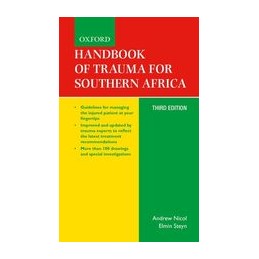Opis
The Handbook of Trauma is an invaluable resource for medical staff and students working in trauma centres or emergency rooms. Clearly presented for quick reference, the text offers practical guidelines, supported by drawings and other figures to explain the subject matter. The book is suitable for MBChB students taking courses in trauma and emergency medicine, as well as for students of programmes such as BTech in pre-hospital emergency care, MMed, FCS or MPhil. In addition,doctors, primary health care workers, nurses and emergency medical services personnel will find value in this clear and practical approach to trauma.
Szczegóły produktu
Indeks
88219
EAN13
9780190408282
ISBN
9780190408282
Opis
Rok wydania
2018
Numer wydania
3
Oprawa
miękka foliowana
Liczba stron
504
Waga (g)
486
Part 1 - Resuscitation and early management; Chapter 1 - Prehospital Careand mass casualty management; Chapter 2 - Initial Assessment; Chapter 3 - Cardiopulmonary resuscitation; Chapter 4 - Airway management; Chapter 5 - Shock and fluid therapy; Chapter 6 - Blood transfusion therapy; Chapter 7 - Emergency procedures; Chapter 8 - Practical aspects of abdominal exploration in the trauma patient; Chapter 9 - Damage control surgery; Chapter 10 - Radiology; Chapter 11 - Pain management; Chapter 12 - Nursing the trauma patient; Part 2 - Regional injuries and management; Chapter 13 - Head injuries; Chapter 14 - Spinal Injuries; Chapter 15 - Maxillofacial and oral injuries; Chapter 16 - Ear and nasal injuries; Chapter 17 - The injured eye; Chapter 18 - Injury to the structures of the neck; Chapter 19 - Cardiac injuries; Chapter 20 - Blunt chest injuries; Chapter 21 - Penetrating chest injuries; Chapter 22 - Abdominal injuries; Chapter 23 - Splenic injuries; Chapter 24 - Liver trauma-Jake Krige; Chapter 25 - Pancreatic trauma; Chapter 26 - Vascular trauma; Chapter 27 - Urinary tract-Chris Heyns; Chapter 28 - Resuscitative management of pelvic fractures; Chapter 29 - Crush injury and myoglobinaemia; Chapter 30 - Hand injuries; Chapter 31 - Fractures and dislocations; Chapter 32 - Emergency care of survivors of sexual offences; Part 3 - High-risk patients; Chapter 33 - Trauma in the elderly; Chapter 34 - The injured child; Chapter 35 - Trauma in pregnancy; Chapter 36 - HIV and trauma; Part 4 - Specific mechanisms of injury and their management; Chapter 37 - Burns; Chapter 38 - Barotrauma and decompression injury; Chapter 39 - Non-accidental trauma; Chapter 40 - Gunshot wounds and blast injuries; Chapter 41 - Bites and toxic stings; Part 5 - Prevention and management of complications; Chapter 42 - Respiratory failure; Chapter 43 - Accidental Hypothermia; Chapter 44 - Acute renal dysfunction; Chapter 45 - Abdominal compartment syndrome; Chapter 46 - Antibiotic use in trauma; Chapter 47 - Nutritional support in trauma; Chapter 48 - Psychological trauma; Part 6 - Trauma-related issues; Chapter 49 - Scoring systems in trauma; Chapter 50 - Medico legal aspects of trauma; Chapter 51 - Brain death and organ donation;


 Dostawa
Dostawa
 Płatność
Płatność
 Zwroty
Zwroty
